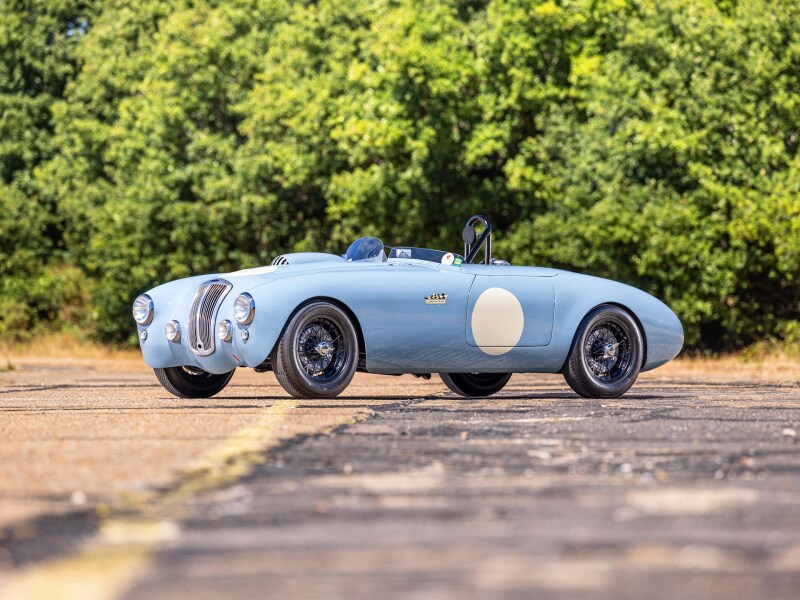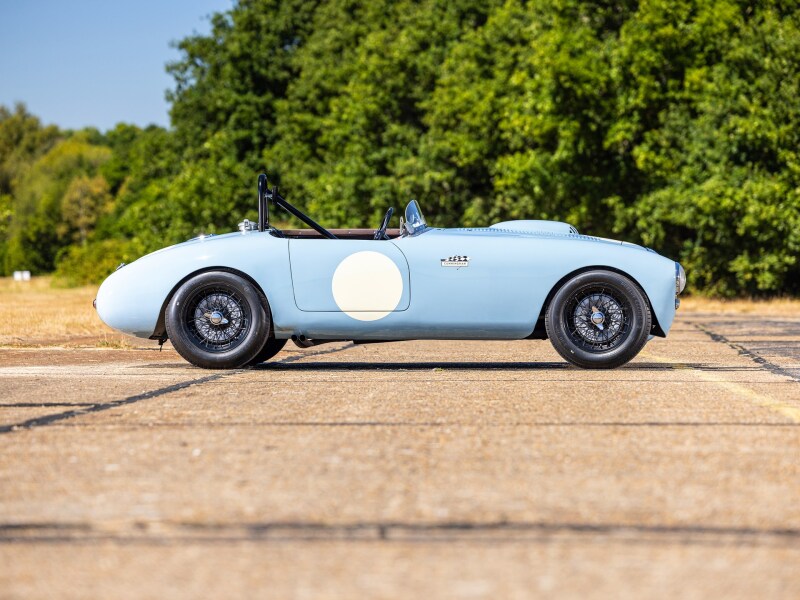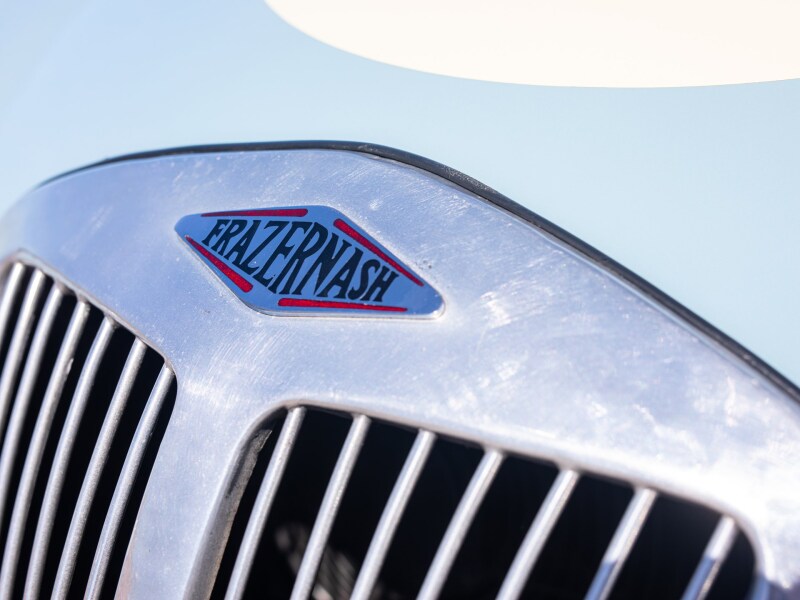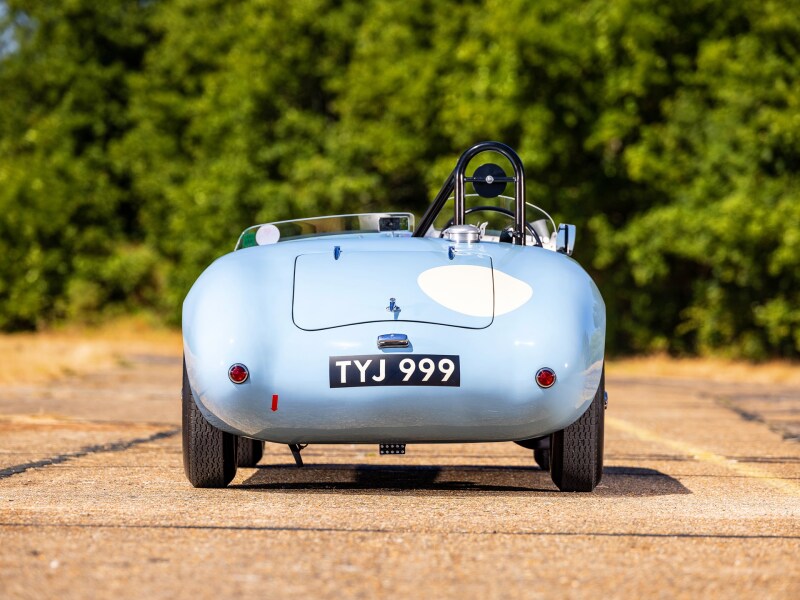









Frazer Nash
Targa Florio
Complimentary Shipping
Price upon request
International shipping available
Customs duties and taxes may apply.
Ships from: Pistone, United Kingdom
Taxes not included
VAT and other taxes are not reflected in the listed pricing. Read more
Details
Description
One of the finest British sports cars of the early 1950s, one of ten Targa Florio Mk1s produced
• Ordered new by Briggs Cunningham and displayed by Frazer Nash at the 1952 Earls Court Motor Show
• Entered by Cunningham into the 1953 12 Hours of Sebring
• Raced by Briggs Cunningham, Charles Moran and John Gordon Bennett
• Presented with its matching-numbers engine and original body
• Fully restored by Nick Finburgh of Classic Autos
• Recently raced at the Goodwood Revival and Members’ Meeting
• Shown at the Concours of Elegance at Hampton Court, and toured on the Bassano Rally
• Offered for £495,000 GBP
The early 1950s was an extraordinary period of many small manufacturers producing wonderfully unique sports cars for the booming American and recovering European markets. These cars were often entirely hand-built which resulted in relatively high sale prices and subsequent low production numbers. Many were great designs and competitive but Jaguar’s XK120, offered at an extraordinarily low price, meant that these small companies sought other business opportunities by the late 1950s.
One of these manufacturers was Frazer Nash, named after its founder Archibald Nash, which produced small-capacity chain-driven sports cars from the 1920s up to the Second World War, later under the care of the Aldington brothers. Prior to WWII, Frazer Nash had become the importer and assembler of RHD BMWs, cars which were hugely advanced for their time. War reparations saw BMW’s designs become owned by Bristol, who would go on to produce their own cars with these designs and provide slightly updated BMW engines to other manufacturers included Frazer Nash. In an agreement for engine supply, Frazer Nash would become part-owned by Bristol with Aldington brothers retaining a significant interest. Once Frazer Nash production ceased, the Aldington brothers continued Frazer Nash as AFN Ltd, the UK importers for Porsche, only selling the company to the German manufacturer in 1987.
Frazer Nash was a company that continually punched far above its weight. During the pre-war period it had an outstanding rally record, whilst AFP Fane famously beat Raymond Mays’ ERA to the hill record at Shelsley Walsh. Post-war, Frazer Nashes claimed 3rd overall at the 1949 24 Hours of Le Mans, outright victory at both the 1951 Targa Florio and the inaugural running of the 12 Hours of Sebring in 1952. What was key for Frazer Nash was that it produced lightweight and agile cars, with relatively powerful 2.0-litre six-cylinder Bristol engines, all in a reliable package. The lightweight, small-capacity approach would become the mainstay of the British approach to motorsport, something that continues to this day. The first thing anyone who drives a competition-prepared Nash will notice is how well they handle, and this is a quality that helped win races in the mid-century and still delights drivers to this day.
The Targa Florio model was aimed at being a slightly lower-cost model, with a similar parallel-tube chassis to the Le Mans Rep Mk II, clothed in a sporty closed-wheel body. The price difference ended up being minimal, but Targa Florios were available in Turismo (100 bhp) and Gran Sport (125 bhp) specifications. Despite the lower price, the Targa Florio was still double the price of a Jaguar XK120 Roadster and resulting demand meant that only 15 examples were built, 10 of which were the sportier Mk1s. Targa Florios were produced in two body styles, the earlier and more desirable is the "short tail" body with the unmistakeable Frazer Nash grille, while the later cars received longer bodies with an open nose, essentially a roofless Le Mans Coupe. As a testament to the Frazer Nash build quality and desirability, the vast majority of the 85 post-war cars still exist today.
Spurred on by the Colliers, Briggs Cunningham’s love of motorsport became increasingly dominant in his life by the early 1950s. Being a proud American, his desire to put an American car on the top step of sports car racing saw him pour money into his B.S. Cunningham Company, which produced the monstrous C4-Rs. Not to hedge his bets on his project, Cunningham continued to buy the finest sports cars Europe had to offer.
Having witnessed a Le Mans Rep win the 1952 12 Hours of Sebring, Cunningham placed an order for the Targa Florio offered, chassis number 412/200/175, during the summer of 1952. As a favor, Cunningham allowed the company to display his car at the 1952 Earls Court Motor Show. Photographs of the car were used for press road tests, but it is not known if it was used as a demonstrator. Delivered in Valentine San Remo Blue and Gran Turismo specification, it is clear this Targa Florio’s competition life was planned from the start as it was fitted from new with features such as a single-windscreen for the driver, bonnet louvres and a lightweight body. It is believed to be the lightest of the Targa Florios to leave the factory. After the show, the Targa Florio was shipped over to Cunningham preparer Alfred Momo in time for its first race, and the competition debut for the model.
This Frazer Nash was entered for its first race with Briggs Cunningham competing in the 6 Hours of MacDill, but unknown circumstances meant that he drove his OSCA MT4 instead.
Cunningham had high hopes for the 1953 12 Hours of Sebring. Fielding a team of three cars, he took a high-risk strategy for overall victory but gave himself a great chance of taking class honors. Instead of fielding a team of Hemi-engined Cunninghams, he fielded one C4-R, an OSCA MT4 and this Frazer Nash Targa Florio, all in different classes. For Cunningham, the race went superbly well, the C4-R took overall victory for John Fitch and Phil Walters, while the OSCA MT4 scored class victory in the hands of Cunningham and Bill Lloyd. The Targa Florio, in the hands of John Bennett and Charles Moran Jr, was on course for a potential class win until its wheel nuts worked loose due to the unrelenting bump surface of Sebring’s airfield. Bennett and Moran would repeat their partnership more successfully in a Cunningham C4-RK at the 1953 Le Mans race.
After the Sebring race, the hubs were replaced so this Targa Florio changed from running on steel wheels to wires, and to accommodate the larger wheels, the wheel arches were very subtly flared out, creating a sportier appearance.
Charles Moran Jr was a major figure in the US motor racing world. As the first American to race in the 24 Hours of Le Mans, he then went on to race in the Indianapolis 500. Moran was a great friend of Cunningham and became an integral member of his team, often driving C4-Rs in major races. Moran would go on to lead the SCCA, represent America at the FIA and set up ACCUS. He would go on to buy several race cars off Cunningham, including this Frazer Nash.
Reunited with this Frazer Nash in 1954, Moran put it to good use at the SCCA races at Westover, finishing 7th in the big-engine race behind a Ferrari 375 MM, a 225 S and some Jaguars. Moran would run his Targa Florio in SCCA races at Cumberland and Montgomery through to 1956, but its most important race appearance in his ownership would be the 1954 Watkins Glen GP where this Frazer Nash was on the grid with the finest sports cars in America: Cunningham C4-Rs, Ferrari 375 MMs, 375 Mexico, 250 MM, 225 S, Jaguar C-type and a Maserati A6GCS. The competition was tough, but this Targa Florio finished in 16th.
Following Moran’s death in 1970, his collection was split up and it is believed that this Frazer Nash passed to the hands of Vernon Pradon before being bought by Ed Osborn in 1980. By 1986, respected Frazer Nash authority and restorer, Bill Roberts, had purchased this historic Targa Florio and brought it back to the UK. Roberts proceeded to restore this Targa Florio before selling it to David Hargreaves in 1995, who would go on to keep it for many years. Eventually it was sold to famed racer, entrant and Jaguar-preparer John Coombs who carried out another restoration, painting it in British Racing Green, with matching green interior. Coombs also commissioned a full rebuild of its original BS1 engine. It is known that Coombs used this Targa Florio as one of his favored road cars in the final two years of his life, particularly for journeys to Goodwood. Sadly, he passed away in 2013 and it was sold as part of his estate.
In 2015, it was sold to Guy Harman who commissioned Nick Finburgh of Classic Autos to carry out a full restoration to bring this wonderful Targa Florio back to its period specification. No expense was spared in returning this Nash to its correct Valentine San Remo Blue (discovered in the fuel filler neck) with a single-windscreen and subtly flared wheel-arches.
Since the restoration, this Targa Florio has competed in the Freddie March Memorial Trophy at the Goodwood Revival, one of the most popular races due to the quality of the grid. Other events include the Goodwood 77th Members’ Meeting, La Leggenda Di Bassano 2019 and the 2019 Concours of Elegance at Hampton Court. Most recently this Frazer Nash has had its original matching-numbers engine reinstalled and dyno tested.
Very few Frazer Nashes formed part of such a famous team as Cunningham's, let alone competed in one of the major sports car races of the period. This highly original Targa Florio is presented with its original chassis, engine and body, and would make the perfect tool for some of the finest events in the world from the Monaco Historique Grand Prix and Le Mans Classic to the Copperstate 1000.
Condition Report
Car Type
Convertible
Car Model
Car Style
British Cars
- ,
European Racing Cars
Region
Country
Year
Color
Blue
VIN Number
Chassis Number
Engine Number
Conditions of Business
Please note that the cancellation right for EU/UK purchasers applies to this item. Please read Condition 19 of the Buy Now Marketplace Conditions of Business for buyers for more information. Read more here.